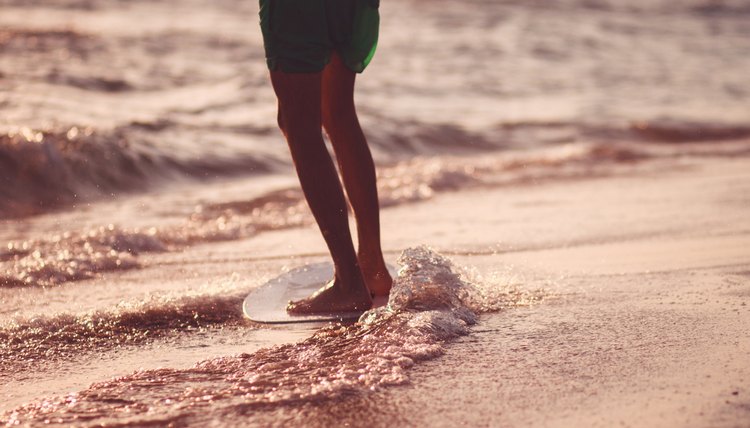The Difference Between a Body Board and a Skim Board

Bodyboarding and skimboarding are water sports that originated in Southern California. Lifeguards in Laguna Beach invented skimboards in the 1920s to make it easier for them to travel across the beach. Laguna Beach is still a prime location for skimboarders and the site of the Skimboard World Championship. In 1973, California resident Tom Morey invented the bodyboard, which is distinctly different from a skimboard. His first bodyboard, Morey's Boogie, led to the name "boogie board."
Materials
Skimboards were originally made from water-sealed plywood. Even though wood boards are still available, most are now made with a polyurethane foam core. The core is covered with either fiberglass or the stronger, stiffer carbon fiber, and the outer layer is made of resin, which serves as a protective coating. Inexpensive bodyboards are often made from single-foam molds of polystyrene, the same material used to make foam cups. High-performance bodyboards are made with a plastic core, foam on the edges and deck and carbon fiber stringers, or rods, inside the core for extra stability. The bottom of a bodyboard, called the slick, is plastic and the top is a softer layer of foam.
Size and Shape
Skimboards are similar in shape to surfboards, but are shorter and wider. They are usually about 3 feet long, 18 inches wide and less than an inch thick. Skimboards made from polyurethane foam weigh about 3 pounds, compared to nearly 20 pounds for wooden boards. Bodyboards have a more rectangular shape than skimboards, with a somewhat pointed nose and a broader tail. They are usually about 4 feet long, 2 feet wide and 2 inches thick. Bodyboard tails come in two different shapes. The crescent tail looks like a semicircle and holds waves better, while the bat tail resembles bat wings and offers more maneuverability. Noses can vary in shape and size, with wider noses providing more stabilization.
Riding the Boards
Similar to surfing, bodyboards are ridden out in the water on waves. Most casual riders ride in the prone position. However, bodyboarding attracts all levels of riders, including expert riders on the world tour who kneel or stand on the board and perform high-speed maneuvers that rival moves seen in a surfing competition. Skimboards are ridden close to shore. To begin your ride, run at an angle toward a wave and drop the board. As the board hits the sand, run onto the board and hydroplane across the shallow water. The movements are comparable to sliding on ice. Skilled riders do surfing-style tricks on the approaching wave.
Leashes
A bodyboard leash is an important piece of equipment used by riders of all skill levels. It is most often a urethane coiled cord that is attached to a point below the board's nose. The other end of the cord has a cuff that you can wear on your wrist or biceps. Without a leash, a bodyboard could be washed up onshore after a wipeout and, in the process of being thrown around by waves, seriously hurt you or someone else. Because of the way you must run with your skimboard to ride it, as well as the fact that you ride it very close to shore, skimboards do not have leashes.
References
Writer Bio
Amy Lively began writing professionally in 2010. She brings expertise in sustainability, careers, nonprofit organizations, photography and American history. Lively holds a Bachelor of Arts in behavioral science from Midland College and a Master of Arts in American history from American Public University in West Virginia.
